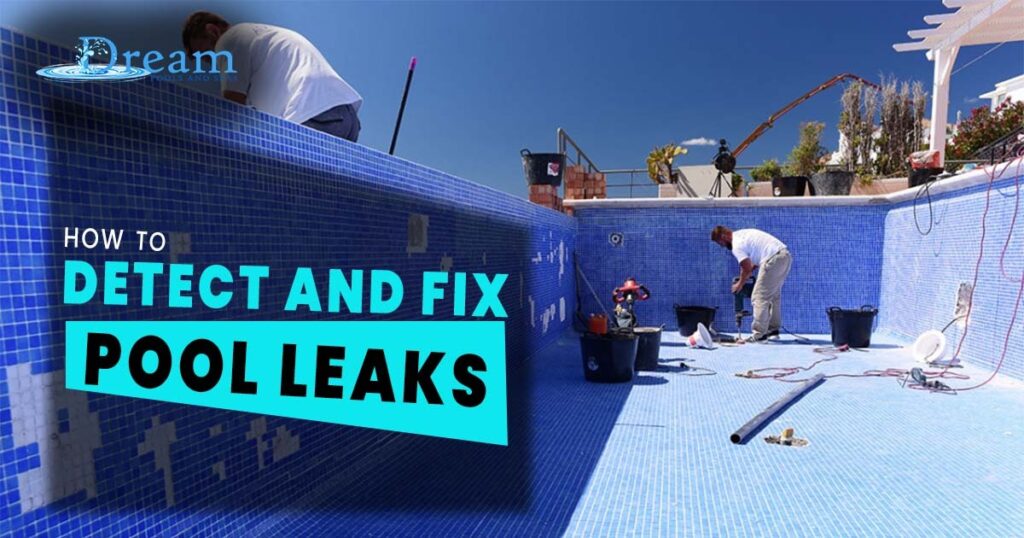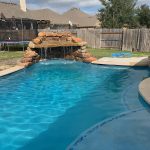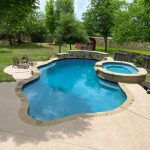Owning a pool is a luxury that brings joy and relaxation, but it also comes with the responsibility of maintenance. One of the most common issues pool owners face is leaks, which can lead to water loss, increased chemical usage, and potential damage to the pool structure. Fortunately, detecting and fixing pool leaks doesn’t have to be daunting. In this step-by-step guide, we’ll walk you through the process, ensuring your quality pool and spa remain in top condition.
For More Information Read Our Blogs:
-> Protecting Your Swimming Pool From Cicada Emergence in Illinois Summer 2024
-> How to Make and Lay a Versailles Tile Pattern
Step 1: Identify the Signs of a Pool Leak
Before you can fix a pool leak, you need to know whether you have one. Some common signs include:
- Water Level Dropping: If your pool’s water level drops more than 1/4 inch per day, this could indicate a leak.
- Higher Water Bills: Increased water usage without any additional activities can be a sign of a leak.
- Wet Spots Around the Pool: Wet or muddy areas around the pool that don’t dry out could be due to an underground leak.
- Algae Growth: Leaks can disrupt the chemical balance, leading to unexpected algae blooms.
- Air in the Pump System: If you notice bubbles or air in the pump, it might be pulling in air through a leak.
Regular checks on your quality pool and spa can help you catch these signs early.
Step 2: Perform a Bucket Test
The bucket test is an easy and effective way to confirm whether your pool has a leak. Here’s how to do it:
- Fill a Bucket: Fill a bucket with pool water and place it on a step in the pool. Ensure the water level inside the bucket matches the pool water level outside.
- Mark the Water Levels: Use a piece of tape or a marker to mark the water level inside the bucket and on the outside of the bucket where the pool water reaches.
- Wait and Compare: After 24-48 hours, compare the water levels. If the pool water level has dropped more than the bucket’s water level, you likely have a leak.
This simple test can save you time and money by confirming whether your quality pool and spa is leaking.
Step 3: Inspect the Pool Equipment
Once you’ve confirmed a leak, the next step is to inspect your pool equipment. Common culprits include:
- Pumps and Filters: Check for leaks around the pump and filter. Look for any visible water drips or puddles.
- Plumbing: Inspect the plumbing lines for cracks, loose fittings, or wet areas.
- Heater: If you have a pool heater, ensure it is not leaking water.
Careful inspection of these areas can help pinpoint the source of the leak in your quality pool and spa.
Step 4: Check the Pool Liner and Structure
If the equipment checks out, the next step is to inspect the pool liner and structure. Look for:
- Cracks in the Pool Walls or Floor: These can occur in concrete, fiberglass, or vinyl pools.
- Tears in the Vinyl Liner: Even a small tear can lead to significant water loss.
- Loose or Missing Tiles: In tiled pools, loose or missing tiles can indicate structural issues leading to leaks.
A thorough inspection of your quality pool and spa structure will help identify any problem areas.
Step 5: Use a Leak Detection Dye
If you’re still unable to locate the leak, you can use a leak detection dye. This specialized dye can be found at most pool supply stores and works as follows:
- Turn off the Pool Pump: Ensure the water is still.
- Apply the Dye: Carefully squirt the dye around suspected areas, such as cracks or fittings. If there’s a leak, the dye will be drawn into it, pinpointing the location.
Using dye can help you find even the smallest leaks in your quality pool and spa.
Step 6: Repair the Leak
Once you’ve identified the leak, it’s time to fix it. The method will depend on the location and severity of the leak:
- Small Cracks: Use a pool putty or a vinyl patch kit to seal small cracks or tears.
- Larger Cracks: For more significant structural damage, you may need professional repair services.
- Equipment Leaks: Replace any faulty parts in the pump, filter, or plumbing.
Keeping your quality pool and spa well-maintained ensures a longer lifespan and fewer issues down the line.
For More Information Read Our Blogs:
-> How to Make and Lay a Versailles Tile Pattern
-> How to Vacuum Your Inground Swimming Pool
Conclusion
Detecting and fixing a pool leak may seem like a daunting task, but with a systematic approach, it’s manageable. By following these steps, you can ensure your quality pool and spa remain in excellent condition, providing you with years of enjoyment. Regular maintenance and prompt repairs will keep your pool in top shape, saving you time, money, and water in the long run.











